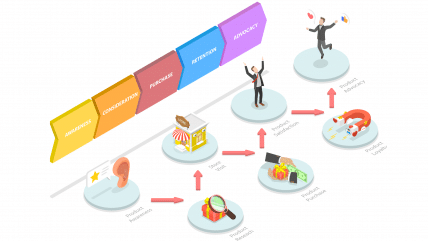Take a moment to think about the last big ticket item you purchased. What types of things did you do before making that purchase? How did you research your options? What helped you make a decision?
For me, it was a laptop.
I spent time visiting multiple websites to read about the laptops I was considering. I watched some YouTube reviews. I hummed and hawed, and asked my friends what they would choose. I went in store and spent time playing around with the laptops they had on display. I looked on Reddit to see what others were saying.
It got to the point where the number of options and information that I had consumed was overwhelming. So much so that I even decided at one point, “Forget it, I don’t need a new laptop. I’ll just keep using the one I have.”
(After months of deliberation, I ended up going with a Microsoft Surface Laptop Studio, in case you were wondering. But that’s not the point here.)
The point is, is that it was a less than ideal buying experience.
And it’s a good example of why the traditional customer journey map as we know it just doesn’t make sense anymore.
The Evolving Buyer’s Journey
Buyers no longer enter a simple path and go through all the stages in a linear, predictable fashion. Instead, they weave in and out of the various stages of the buying process, making the traditional customer journey map an inaccurate representation of the path they take.
To understand the modern buyer and sell to them effectively, companies need to embrace a non-linear approach that is aligned with how customers want to buy. This means acknowledging that customers can enter, exit, and re-enter the buying journey at any point.
It also means it’s time to update your customer journey map.
Here’s how you can get started.
How to Create a Customer Journey Map
1. Research and gather data
Before you begin mapping the customer journey, you need to start by collecting data on your customer’s interactions with your brand. This includes looking at your website analytics, customer surveys, social media comments, and customer support records.
You can use a number of different tools for gathering your data. I’d recommend using a tool such as Sparktoro for gathering in-depth audience insights, and, of course, Google Analytics for drilling down into your website analytics.
You likely will want to look into a social listening tool to find mentions of your brand on social media. (By the way, the social listening feature in Agorapulse works brilliantly for this kind of thing.)
It also can be incredibly useful to spend time interviewing customers to understand their experiences in greater detail and depth than you can get from looking at just the numbers. This will help you see the story behind the data you have gathered and make it easier to understand the journey from the customer’s point of view.
2. Identify the customer journey stages
The customer journey is typically broken up into several stages that each represent a different phase of the customer’s experience.
This typically will include stages like awareness, consideration, purchase, and post-purchase. Mapping these stages enables you to see how your customers move through their journey and identify areas for improvement.

Image credit: Andrii Toryanik, Canva
3. Identify touch points
Next, you’ll want to list all of the touch points where customers interact with your brand. Yes, all of them. This should include your website, social media profiles, emails, or physical locations if applicable.
Remember to be thorough in this step. It’s easy to gloss over touch points that aren’t direct interactions with your brand, but it’s important that they are still included in the customer journey map.
For example, you want to include customer actions like reading reviews on third-party sites, or watching user-generated content – both of which can heavily influence a customer’s decision to engage with your brand.
Including these non-branded touchpoints is essential to mapping the customer journey accurately, as it allows you to view things from the customer’s perspective. It helps you understand where your customers gather information, and how that information influences their buying decisions.
4. Map the touch points
Connect each of your identified touch points to the corresponding customer stage they occur in. For example, social media might be an awareness touchpoint, whereas a customer review might be a consideration touchpoint. Keep in mind there are likely multiple touch points for each of the steps, and some touch points may be applicable to more than one step.
5. Identify emotions and pain points
Emotional engagement has become a core aspect of the modern customer journey. Customers seek not only functional solutions but also emotionally satisfying experiences. Mapping emotions at different stages in the buyer’s journey will help you understand and cater to customer expectations more effectively.
At each stage, identify the emotions customers may feel. Are they frustrated, excited, or confused?
Also take note of the issues or challenges that customers might encounter during the buying process and connect them to the step or touchpoint that they occur.
6. Find opportunities and form solutions
Now that you have the customer journey map laid out, you can use it to create strategies that will alleviate friction that prevents the customer from completing a purchase. Brainstorm solutions that will help you enhance the customer experience and make each touchpoint more effective.
By using a proactive customer-centric approach, you will be able to form strategic solutions that resonate profoundly with the needs of your audience and are in tune with how they want to buy. This thoughtful consideration of your customers preferences will make it easier for them to progress from one stage of the journey to the next, and increase your conversions.
7. Validate and refine your customer journey map
Customer journey mapping isn’t just one and done. It is an ongoing process. Regularly update your customer journey map to reflect changes in customer behaviour, technology, or your business offerings.
To Sum Things Up
As the traditional, linear customer journey gives way to a more intricate and unscripted path, businesses must adapt if they want to stay in touch with the modern buyer. Adapting, in this case, means taking the time to adjust your customer journey map so it’s aligned with your customer’s buying patterns.
This will help create a more personalized, engaging, and ultimately, meaningful relationship with your customers that supports long-term business growth.
Agorapulse can help you understand your customers on a new level with the social listening feature. Check out a free demo to see it in action.






